The Gem Equipment
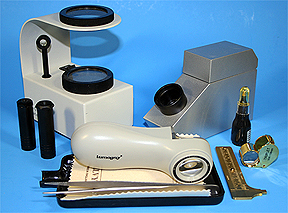 There is nothing more important to a gemologist that his or her gemological testing equipment. For some this may mean a lot of expensive and cumbersome equipment. For others it may mean only a few instruments carried in a shirt pocket. But regardless of how many instruments you require, it is important to be fully aware of the ability of each one to its fullest. Here are some of the most often used gemological testing equipment, and how YourGemologist ranks them in importance.
There is nothing more important to a gemologist that his or her gemological testing equipment. For some this may mean a lot of expensive and cumbersome equipment. For others it may mean only a few instruments carried in a shirt pocket. But regardless of how many instruments you require, it is important to be fully aware of the ability of each one to its fullest. Here are some of the most often used gemological testing equipment, and how YourGemologist ranks them in importance.
Gemological Binocular Microscope
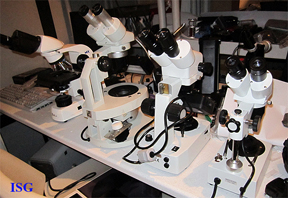 These are great if you are always in your office or store. But how often do you do your buying of gemstones in your store or office? These microscopes are great for research, retail selling, and identification of difficult gemstones such as some synthetics. But no gemologist worth their salt should rely solely on one of the big, expensive monsters for synthetics, anyway. If you are in the field (or out on the streets) they are difficult, if not impossible, to carry. And you will almost never find a plug when you need one. Best to train to grade and identify gemstones with a 10X hand loupe. Then, when you get asked to make that special buying trip to the tanzanite fields of Tanzania, you won’t have to pay extra air fees for your luggage that is overloaded with your microscope. And….where are you going to plug the damned thing in, anyway! Save your money on a moderate scope for the office or store, and put your money into something useful like a full size spectroscope…or more inventory for your store. Let’s face it, has anyone thought about why the New York Diamond Dealers Club does not have rows upon rows of big expensive microscopes lined up on the tables. Because they don’t need them.
These are great if you are always in your office or store. But how often do you do your buying of gemstones in your store or office? These microscopes are great for research, retail selling, and identification of difficult gemstones such as some synthetics. But no gemologist worth their salt should rely solely on one of the big, expensive monsters for synthetics, anyway. If you are in the field (or out on the streets) they are difficult, if not impossible, to carry. And you will almost never find a plug when you need one. Best to train to grade and identify gemstones with a 10X hand loupe. Then, when you get asked to make that special buying trip to the tanzanite fields of Tanzania, you won’t have to pay extra air fees for your luggage that is overloaded with your microscope. And….where are you going to plug the damned thing in, anyway! Save your money on a moderate scope for the office or store, and put your money into something useful like a full size spectroscope…or more inventory for your store. Let’s face it, has anyone thought about why the New York Diamond Dealers Club does not have rows upon rows of big expensive microscopes lined up on the tables. Because they don’t need them.
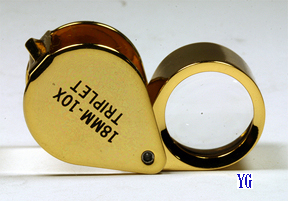 10x Triplet Jeweler’s Loupe
10x Triplet Jeweler’s Loupe
This is the instrument of choice of the best gemologists. With this you can separate synthetic moissanite or cubic zirconia from natural diamond, clarity grade a diamond, cut grade a diamond…and you don’t have to plug it in anywhere. Fits in your pocket. Show me a gemologists who can’t do a complete diamond analysis with just the loupe, and I will show you a gemologists who is not worth much on a buying trip. Learn to grade with just a loupe! It will be the greatest benefit to your gemological ability that you will learn.
Mag Light with Dark Field

If you want to be creative get yourself one of the cool MagLite’s with a dark field illumination attachment. It has a built-in 10x loupe that works well. Its meant for those of you who need dark field illumination to do clarity grading, but are smart enough to know better than carry a microscope around with you in your luggage.
Refractometer
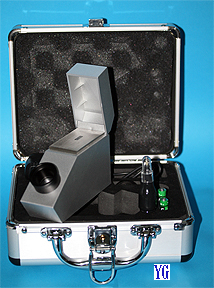 One of the most important tools in the gemologist’s tool set. The refractometer can give you the refractive index including the optic character and sign of the gemstones, if you are properly trained. But far too many people think you just put the stone on the refractometer, read the RI and make the identificatin. This is just not correct. One must be properly trained to know how to use the refractometer properly and to get the most from its testing ability. The new generation of refractometers is seen above with a cubic zirconia hemicylinder that is far easier to use and much less likely to get scratched. Remember, training and practice are very important with the refractometer. Very important tool but with that comes the need for proper training.
One of the most important tools in the gemologist’s tool set. The refractometer can give you the refractive index including the optic character and sign of the gemstones, if you are properly trained. But far too many people think you just put the stone on the refractometer, read the RI and make the identificatin. This is just not correct. One must be properly trained to know how to use the refractometer properly and to get the most from its testing ability. The new generation of refractometers is seen above with a cubic zirconia hemicylinder that is far easier to use and much less likely to get scratched. Remember, training and practice are very important with the refractometer. Very important tool but with that comes the need for proper training.
Jemeter (infrared reflectance meter)
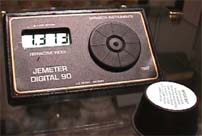 Now here is a tool never to leave home without. Although it is not taught much in the United States, the Jemeter is the best tool for testing refractive index of a stone. Its digital, it runs on batteries so its portable. And it will read far beyond the 1.81 reading of the normal glass version of refractometer. And it will also test for birefringence so no need for a polariscope. It requires some care to maintain calibration…but then if you are going to own gemological equipment you need to get used to caring for your equipment anyway. And how difficult are they to use? I carried the one in this picture for over 10 years and 400,000 miles around the Caribbean. Never failed once. And not once did I ever carry a traditional refractometer in my suitcase. Did not need one. These may be hard to find now since they have not been in production for a number of years, but if you can find one you should seriously consider buying it.
Now here is a tool never to leave home without. Although it is not taught much in the United States, the Jemeter is the best tool for testing refractive index of a stone. Its digital, it runs on batteries so its portable. And it will read far beyond the 1.81 reading of the normal glass version of refractometer. And it will also test for birefringence so no need for a polariscope. It requires some care to maintain calibration…but then if you are going to own gemological equipment you need to get used to caring for your equipment anyway. And how difficult are they to use? I carried the one in this picture for over 10 years and 400,000 miles around the Caribbean. Never failed once. And not once did I ever carry a traditional refractometer in my suitcase. Did not need one. These may be hard to find now since they have not been in production for a number of years, but if you can find one you should seriously consider buying it.
Polariscope
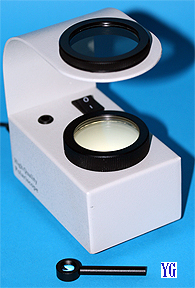 The polariscope is a critical piece of equipment for any gemologist’s office. It can easily identify single and double refractive gemstones, and in many cases allow you to view the optic interference figure and give you the optic character of the gemstone. Too large and difficult for travel, but on the desk of a properly trained gemologist the polariscope can help make gemstone identification far more accurate and efficient.
The polariscope is a critical piece of equipment for any gemologist’s office. It can easily identify single and double refractive gemstones, and in many cases allow you to view the optic interference figure and give you the optic character of the gemstone. Too large and difficult for travel, but on the desk of a properly trained gemologist the polariscope can help make gemstone identification far more accurate and efficient.
Dichroscope
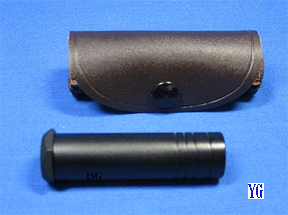 Very useful tool that no gemologist should be without. Critical in identifying many synthetic and imitation gemstones. The dichroscope allows you to actually see the pleochroism in a gemstone, in other words it allows you to see the multiple colors that many gemstones produce. Since your eyes cannot separate these colors in most cases, the dichroscope uses calcite crystals to separate the light waves and allow you to see the seperate colors. This is a very important addition to your testing tools and one that no gemologist can be without. Don’t travel without one.
Very useful tool that no gemologist should be without. Critical in identifying many synthetic and imitation gemstones. The dichroscope allows you to actually see the pleochroism in a gemstone, in other words it allows you to see the multiple colors that many gemstones produce. Since your eyes cannot separate these colors in most cases, the dichroscope uses calcite crystals to separate the light waves and allow you to see the seperate colors. This is a very important addition to your testing tools and one that no gemologist can be without. Don’t travel without one.
London Dichroscope
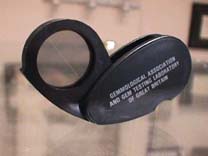 The British came up with a dichroscope that is based on polaroid filters. Works as well as the expensive counterpart above, but costs much less. Not as accurate on individual gemstones that require color separations that are only slight in variation, but an important tool for travel and for looking at parcels of gemstones at once. A very good tool to have in addition to the calcite dichroscope.
The British came up with a dichroscope that is based on polaroid filters. Works as well as the expensive counterpart above, but costs much less. Not as accurate on individual gemstones that require color separations that are only slight in variation, but an important tool for travel and for looking at parcels of gemstones at once. A very good tool to have in addition to the calcite dichroscope.
Chelsea Filter
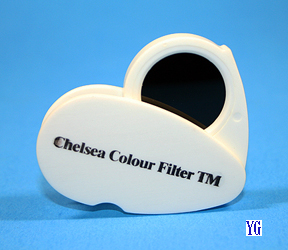 Never, never, never leave home without your Chelsea Filter. As a GIA Graduate Gemologist I can attest to why the GG’s of this world do not understand the Chelsea Filter…the GIA does not teach it properly. It is perceived as some ancient filter once used to ID synthetic emeralds. Not even close! The Chelsea Filter can separate every tanzanite imitation on the market from the real thing. It can identify the chromium content of Colombian emeralds, give a red reaction to natural Lapis Lazuli, show chromium content of jade, separate synthetic blue spinel from natural. So many, many things this little filter can do that US gemologists don’t even know about. Learn about this very important gem identification tool. It is one of the most important tools that will keep you from having to lug all that heavy, electricity eating equipment around with you when you travel. I always carry a Chelsea filter when I travel to shows or mines.
Never, never, never leave home without your Chelsea Filter. As a GIA Graduate Gemologist I can attest to why the GG’s of this world do not understand the Chelsea Filter…the GIA does not teach it properly. It is perceived as some ancient filter once used to ID synthetic emeralds. Not even close! The Chelsea Filter can separate every tanzanite imitation on the market from the real thing. It can identify the chromium content of Colombian emeralds, give a red reaction to natural Lapis Lazuli, show chromium content of jade, separate synthetic blue spinel from natural. So many, many things this little filter can do that US gemologists don’t even know about. Learn about this very important gem identification tool. It is one of the most important tools that will keep you from having to lug all that heavy, electricity eating equipment around with you when you travel. I always carry a Chelsea filter when I travel to shows or mines.
Master Colored Grading Set
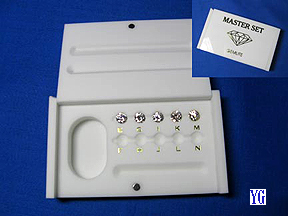 In your store or office these should be diamonds. But few gemologists are gullible enough to travel with a set of master color grading diamonds. I have used a couple of sets of color grading CZ sets for years. I check them on an ongoing basis with an AGS Master Set that we have in the office. So far, no changes in color, in spite of what some places will tell you. If you travel, stay with the CZ master sets. If you are home or office based, you should make every effort to own a set of diamond master color stones.
In your store or office these should be diamonds. But few gemologists are gullible enough to travel with a set of master color grading diamonds. I have used a couple of sets of color grading CZ sets for years. I check them on an ongoing basis with an AGS Master Set that we have in the office. So far, no changes in color, in spite of what some places will tell you. If you travel, stay with the CZ master sets. If you are home or office based, you should make every effort to own a set of diamond master color stones.
Spectroscope
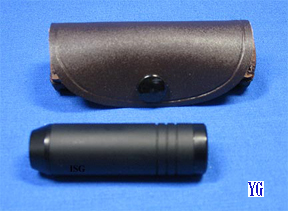 Never, never, never leave home without your spectroscope. Unfortunately, this is another piece of equipment that the GIA falls far short with their training. A gemologist that is well trained with a simple hand held spectroscope can identify so many, many gemstones that it might amaze you. And I mean with nothing else but a hand held spectroscope. That is some training that will serve you well in buying, appraising, and identification of gemstones in the field…no matter what field you are standing in. The spectroscope allows you to see the absorption lines due to elements in a gemstone that allows for identification. A well trained gemologist will always want to have a spectroscope in their tool chest.
Never, never, never leave home without your spectroscope. Unfortunately, this is another piece of equipment that the GIA falls far short with their training. A gemologist that is well trained with a simple hand held spectroscope can identify so many, many gemstones that it might amaze you. And I mean with nothing else but a hand held spectroscope. That is some training that will serve you well in buying, appraising, and identification of gemstones in the field…no matter what field you are standing in. The spectroscope allows you to see the absorption lines due to elements in a gemstone that allows for identification. A well trained gemologist will always want to have a spectroscope in their tool chest.
Specific Gravity Liquids
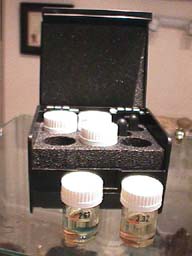 These used to be important for identification of a lot of gemstones…in the office or store. But try taking some on a trip with you! Yikes! Far too toxic. And leave them to sit for a while, and then go back to check if they are still accurate with their SG measurements. No way. You have to start pouring in a little methylene iodide..a little bromoform…a little of this…a little of that. What a headache. Get yourself a carat scale that will hold an attachment and get your specific gravity the old fashion way…hydrostatic weighing. Its more accurate and a lot cheaper. Plus with the toxicity of the SG liquids most gemologists have stopped using them and gone back to using the hydrostatic method of obtaining specific gravity.
These used to be important for identification of a lot of gemstones…in the office or store. But try taking some on a trip with you! Yikes! Far too toxic. And leave them to sit for a while, and then go back to check if they are still accurate with their SG measurements. No way. You have to start pouring in a little methylene iodide..a little bromoform…a little of this…a little of that. What a headache. Get yourself a carat scale that will hold an attachment and get your specific gravity the old fashion way…hydrostatic weighing. Its more accurate and a lot cheaper. Plus with the toxicity of the SG liquids most gemologists have stopped using them and gone back to using the hydrostatic method of obtaining specific gravity.
Electronic Scales
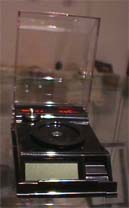
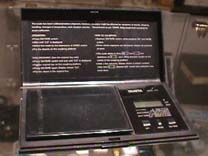 God Bless The Japanese and Americans for developing some digital, electronic scales that are accurate and durable. The carat scale on the far left is from the US company: Dendritics, and the gram/pennyweight scale on the immediate left is from Tanita in Japan. Both have traveled the same 400,000 miles as the Jemeter above. And never once failed and never once got out of calibration. Thank you Dendritics and Tanita. Well done!
God Bless The Japanese and Americans for developing some digital, electronic scales that are accurate and durable. The carat scale on the far left is from the US company: Dendritics, and the gram/pennyweight scale on the immediate left is from Tanita in Japan. Both have traveled the same 400,000 miles as the Jemeter above. And never once failed and never once got out of calibration. Thank you Dendritics and Tanita. Well done!
Ultraviolet Cabinet and Long Wave/Short Wave UV Light
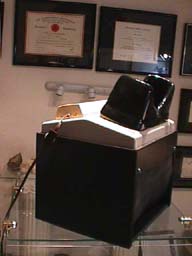 Again, a great tool for the office. But there are several models on the market today that run on battery, give you the same light sources in a far smaller, hand held light source, and don’t take up near as much room. There are a number of models out there so find one that is right for you. But by all means get one. You will need it.
Again, a great tool for the office. But there are several models on the market today that run on battery, give you the same light sources in a far smaller, hand held light source, and don’t take up near as much room. There are a number of models out there so find one that is right for you. But by all means get one. You will need it.
Electronic Metals Tester
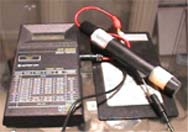 Be very careful about these testers. If the reaction is good then you can probably trust the tool. But if it says not good, that means get another opinion. These are as good as the gemologist using them. Which means everyone should be careful. They are better than trying to carry a vial of hydrochloric or nitric acid around with you. But take negative readings with a grain of salt until you get verification from, preferably, an aqua regis test.
Be very careful about these testers. If the reaction is good then you can probably trust the tool. But if it says not good, that means get another opinion. These are as good as the gemologist using them. Which means everyone should be careful. They are better than trying to carry a vial of hydrochloric or nitric acid around with you. But take negative readings with a grain of salt until you get verification from, preferably, an aqua regis test.
Leveridge Gauge
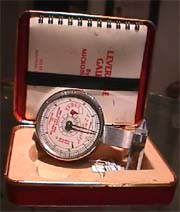 This has been a staple of gemological tools for decades. There are now a lot of fancy digital version on the market which makes it better for old guys like me to read the measurements. But I would not suggest that any gemologist be without one. They are vital in making weight estimations by measurement formula. Spend the money to get a good one. It will be money well spent if you take care of it.
This has been a staple of gemological tools for decades. There are now a lot of fancy digital version on the market which makes it better for old guys like me to read the measurements. But I would not suggest that any gemologist be without one. They are vital in making weight estimations by measurement formula. Spend the money to get a good one. It will be money well spent if you take care of it.
These are the basics when it comes to gemological equipment. How much or how little of it all you need will depend on how experienced and how well trained you are as a gemologist. By far the best training you will find for gemology without the need for a lot of expensive equipment is with the International School of Gemology or the Gemmological Association of Great Britain. Both teach you to understand the “why” of gemology so you don’t need to carry a lot of heavy equipment, and you don’t need to carry a lot of reference books. I highly recommend them to anyone interested in gemology.YourGemologist

